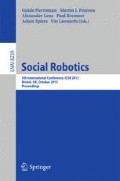Abstract
When planning to carry out an activity, a mobile robot has to choose its placement during the activity. Within an environment shared by humans and robots, a social robot should take restrictions deriving from spatial needs of other agents into account. We propose a solution to the problem of obtaining a target placement to perform an activity taking the action possibilities of oneself and others into account. The approach is based on affordance spaces agents can use to perform activities and on socio-spatial reasons that count for or against using such a space.
This research is partially supported by the DFG (German Science Foundation) in IRTG 1247 ‘Cross-modal Interaction in Natural and Artificial Cognitive Systems’ (CINACS). Thanks to Jianwei Zhang for providing access to the PR2 and the robot lab. Thanks to Johanna Seibt and Klaus Robering for discussions about affordance spaces in the context of ‘Making Space’ and ‘Friends by Design’ and to three anonymous reviewers for their valuable comments.
Access this chapter
Tax calculation will be finalised at checkout
Purchases are for personal use only
Preview
Unable to display preview. Download preview PDF.
References
Althaus, P., Ishiguro, H., Kanda, T., Miyashita, T., Christensen, H.I.: Navigation for human-robot interaction tasks. In: Proc. of ICRA 2004, pp. 368–377 (2004)
Bonnefon, J.-F., Dubois, D., Fargier, H., Leblois, S.: Qualitative heuristics for balancing the pros and cons. Theory and Decision 65(1), 71–95 (2008)
Dubois, D., Fargier, H., Bonnefon, J.-F.: On the qualitative comparison of decisions having positive and negative features. Journal of Artificial Intelligence Research 32(1), 385–417 (2008)
Gibson, J.J.: The Theory of Affordances. In: The Ecological Approach to Visual Perception, pp. 127–143. Lawrence Erlbaum Association Inc. (1986)
Kendon, A.: Conducting Interaction: Patterns of Behavior and Focused Encounters. Cambridge University Press, Cambridge (1990)
Keshavdas, S., Zender, H., Kruijff, G.J.M., Liu, M., Colas, F.: Functional mapping: Spatial inferencing to aid human-robot rescue efforts in unstructured disaster environments. In: Proc. of the 2012 AAAI Spring Symposium on Designing Intelligent Robots, Stanford University. AAAI Press (2012)
Lemaignan, S., Ros, R., Mösenlechner, L., Alami, R., Beetz, M.: Oro, a knowledge management module for cognitive architectures in robotics. In: Proc. of the 2010 IEEE/RSJ Int. Conf. on Intelligent Robots and Systems (2010)
Lindner, F., Eschenbach, C.: Towards a formalization of social spaces for socially aware robots. In: Egenhofer, M., Giudice, N., Moratz, R., Worboys, M. (eds.) COSIT 2011. LNCS, vol. 6899, pp. 283–303. Springer, Heidelberg (2011)
Okada, K., Kojima, M., Sagawa, Y., Ichino, T., Sato, K., Inaba, M.: Vision based behavior verification system of humanoid robot for daily environment tasks. In: Proc. of the 6th IEEE-RAS Int. Conf. on Humanoid Robots, pp. 7–12. IEEE (2006)
Pandey, A.K., Alami, R.: Taskability graph: Towards analyzing effort based agent-agent affordances. In: Proc. of the 2012 IEEE/RSJ Int. Conf. on Intelligent Robots and Systems, pp. 791–796 (2012)
Raz, J.: Practical Reason and Norms. Oxford University Press (1999)
Shiotani, T., Maegawa, K., Lee, J.H.: A behavior model of autonomous mobile projection robot for the visual information. In: Proc. of the 8th Int. Conf. on Ubiquitous Robots and Ambient Intelligence, pp. 615–620 (2011)
Sisbot, E.A., Marin-Urias, L.F., Broquère, X., Sidobre, D., Alami, R.: Synthesizing robot motions adapted to human presence. Int. Journal of Social Robotics 2(3), 329–343 (2010)
Stulp, F., Fedrizzi, A., Mösenlechner, L., Beetz, M.: Learning and reasoning with action-related places for robust mobile manipulation. Journal of Artificial Intelligence Research (JAIR) 43, 1–42 (2012)
Tipaldi, G.D., Arras, K.O.: I want my coffee hot! Learning to find people under spatio-temporal constraints. In: Proc. of the Int. Conf. on Robotics and Automation, pp. 1217–1222 (2011)
Torta, E., Cuijpers, R.H., Juola, J.F., van der Pol, D.: Design of robust robotic proxemic behaviour. In: Mutlu, B., Bartneck, C., Ham, J., Evers, V., Kanda, T. (eds.) ICSR 2011. LNCS (LNAI), vol. 7072, pp. 21–30. Springer, Heidelberg (2011)
Williams, M.-A.: Robot social intelligence. In: Ge, S.S., Khatib, O., Cabibihan, J.-J., Simmons, R., Williams, M.-A. (eds.) ICSR 2012. LNCS (LNAI), vol. 7621, pp. 45–55. Springer, Heidelberg (2012)
Yamaoka, F., Kanda, T., Ishiguro, H., Hagita, N.: A model of proximity control for information-presenting robots. IEEE Trans. on Robotics 26(1), 187–195 (2010)
Zacharias, F., Borst, C., Beetz, M., Hirzinger, G.: Positioning mobile manipulators to perform constrained linear trajectories. In: Proc. of IEEE/RSJ Int. Conf. on Intelligent Robots and Systems (IROS), pp. 2578–2584. IEEE (2008)
Author information
Authors and Affiliations
Editor information
Editors and Affiliations
Rights and permissions
Copyright information
© 2013 Springer-Verlag Berlin Heidelberg
About this paper
Cite this paper
Lindner, F., Eschenbach, C. (2013). Affordance-Based Activity Placement in Human-Robot Shared Environments. In: Herrmann, G., Pearson, M.J., Lenz, A., Bremner, P., Spiers, A., Leonards, U. (eds) Social Robotics. ICSR 2013. Lecture Notes in Computer Science(), vol 8239. Springer, Cham. https://doi.org/10.1007/978-3-319-02675-6_10
Download citation
DOI: https://doi.org/10.1007/978-3-319-02675-6_10
Publisher Name: Springer, Cham
Print ISBN: 978-3-319-02674-9
Online ISBN: 978-3-319-02675-6
eBook Packages: Computer ScienceComputer Science (R0)

